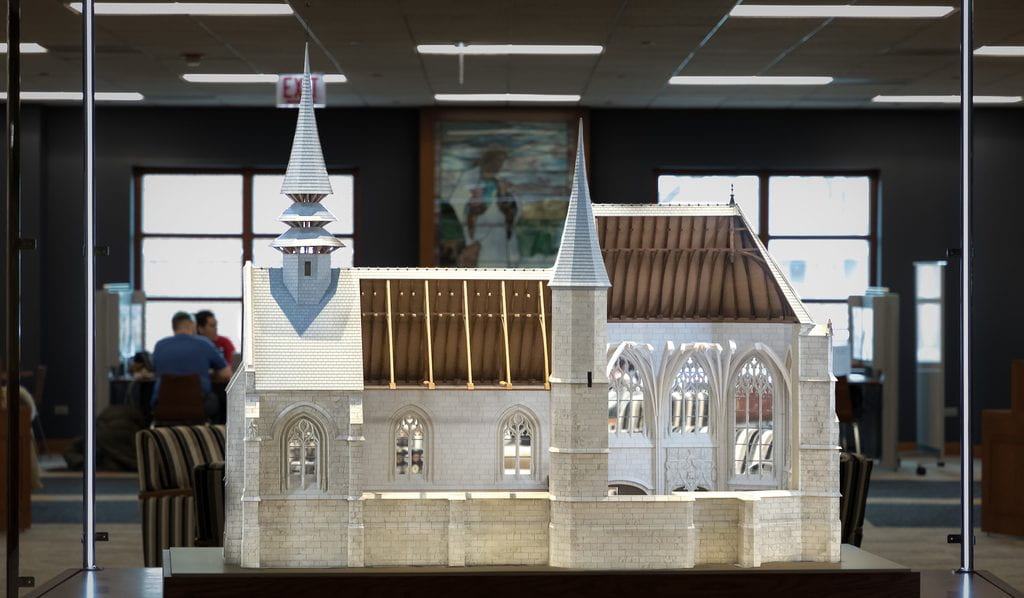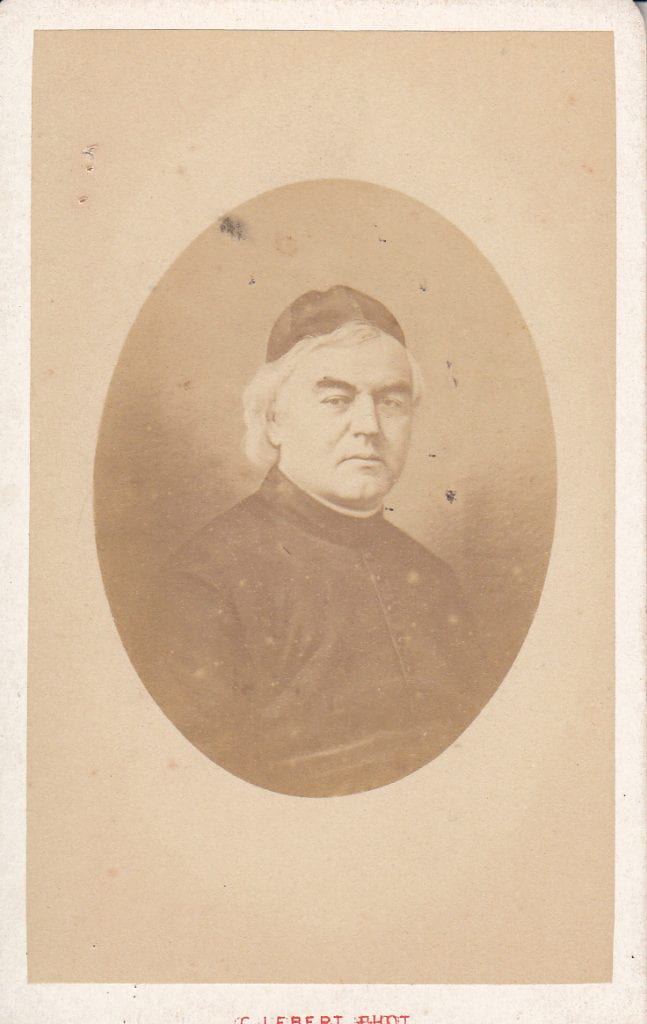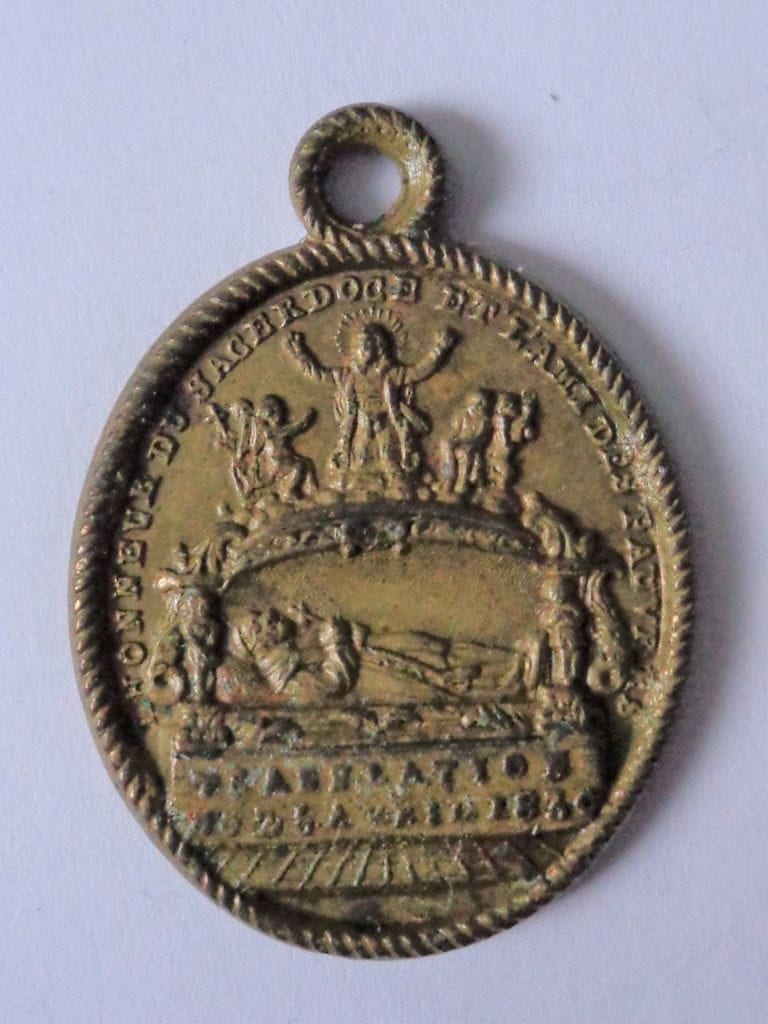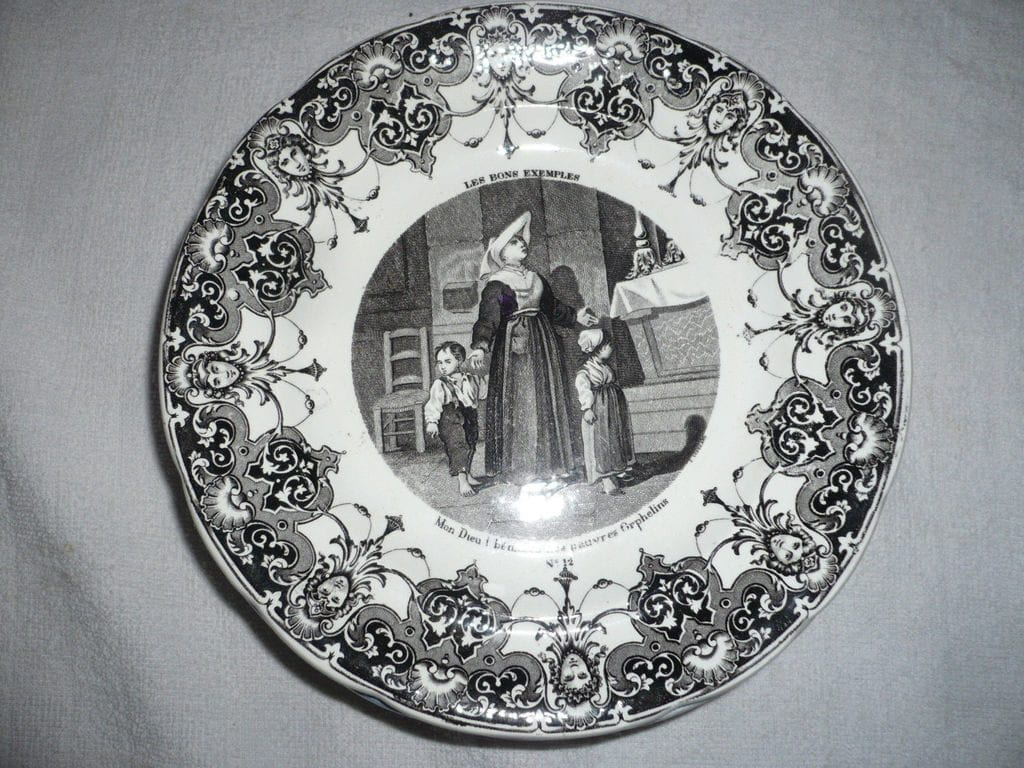An essay written by Virginia Raguin and read by Sarah McNabb. The essay describes the symbolism and detail in the architecture of the church in Folleville, France where Vincent de Paul gave the first sermon on the mission.
Author: bcicirel
Newsnote: Folleville model created to celebrate the close of the 400th anniversary year.

CHICAGO — DePaul University is honoring its Vincentian heritage with an exhibition that transports visitors back to 17th century rural France via a model of a historic church created using traditional craftsmanship and 3-D printing.
The tabletop model of the parish church in Folleville, France, where St. Vincent de Paul delivered a 1617 sermon regarded as the genesis of the Vincentian mission, will be unveiled Jan. 26 at the John T. Richardson Library on DePaul’s Lincoln Park Campus.
The 2 feet wide by 5 feet long model was commissioned by DePaul University’s Vincentian Studies Institute. DePaul is the nation’s largest Catholic university. It was founded in Chicago in 1898 by the Congregation of the Mission (Vincentians), a Roman Catholic religious community begun by Vincent in 1625. Vincent, popularly known as the “apostle of charity,” dedicated his life to serving the poor.
Image of Folleville, France church
A 2016 image of the parish church in Folleville, France, where St. Vincent de Paul delivered a sermon in 1617 considered the genesis of the Vincentian mission. A scale model of the church is displayed at the John T. Richardson Library on DePaul University’s Lincoln Park Campus.
The Rev. Edward R. Udovic, C.M., a historian and DePaul’s vice president for mission and ministry, described the project as “a long time coming” as planning started in 2012. He wanted to find an appropriate way to celebrate the 400th anniversary of the Vincentian mission and believed creating a model of the church located roughly 75 miles northwest of Paris would be an important and unique contribution to the anniversary celebration.
“DePaul University is the premier international center for Vincentian studies,” Udovic said.
The model will be a permanent exhibition in the Richardson Library. Interactive kiosks providing information on the church’s art, architecture and its Vincentian significance flank the structure.
The model shows the church as it was in 1617 prior to the ravages of history and renovations through the centuries. It depicts the original front façade and steeple and the original choir screen made of richly carved wood. Visitors will be able to peer through cross-sections of the model to appreciate the full beauty of both the interior and exterior of the church.
History meets high tech
Jeff Wrona, who created the St. Lazare diorama in the Richardson Library in 1992, provided the architectural research for the concept and structure of the Folleville model. Architectural model firm Presentation Studios International LLC (PSI) of Chicago completed the model.
“The model came together like a large Lego set,” Udovic said. “Each of the major pieces were individually printed out, joined together, hand-finished and painted.”
The interior is without pews or pulpit because those church furniture items were not present in 1617, he added.
Folleville, then and now
In 1617, the church was on the lands of the powerful and noble Gondi family who served as Vincent’s great and generous patrons.
The church, which is no longer an active parish, continues to attract visitors because it is a UNESCO World Heritage Site as a stop on the northern medieval pilgrimage route to Santiago de Compostela, a Spanish city home to the shrine of St. James the Great.
The church at Folleville is significant in art and architectural history as well as Vincentian history. Originally built as a simple parish church at the beginning of the 15th century, it was remodeled at the beginning of the 16th century with the addition of a flamboyant gothic chapel decorated with important Italian late-medieval sculptures and tombs.
Folleville model unveiling
An official unveiling will take place 3 p.m. Jan. 26 at the DePaul Richardson Library, 2350 N. Kenmore Ave. The event will include welcome and remarks by DePaul’s President A. Gabriel Esteban, Ph.D., and Udovic.
The event will include a foundation day celebration hosted by the Vincentian Community of Rosati House. Attendees are asked to register by Jan. 23 to Alice Farrell at afarrell@depaul.edu or 312-362-8822.
Christmas Compassion
Compassion is a year-round virtue, but many of us suffer “compassion fatigue” when faced with the endless stream of stories of the lonely, the sick, the destitute, the abandoned, and the displaced in our world today. What are we to do? Jack Melito, C.M., discusses Vincent de Paul’s instruction about living a life of compassion:
First of all, we must remind ourselves that our first experience of compassion was the compassion we were sown by God. As a result, we must make every effort to be compassionate to ourselves and to others. We must pray for a spirit of Compassion and Mercy. A life of compassionate action will result in a heart open to carrying the sufferings of the poor. Though there may be times when regret creeps in, you must remember that, though you may judge yourself as having neglected opportunities to be merciful and compassionate, you did your best. Therefore, always pray for a spirit of compassion and mercy.
“Christmas Compassion” is a chapter from the book, Windows on His Vision, (pp. 112-113) available at: https://via.library.depaul.edu/windows/3/
It is also available as an ebook here: https://via.library.depaul.edu/vincentian_ebooks/8/
Newsnote: Vincentiana Purchase of the Week Jean-Baptiste Etienne carte-de-visite
The Vincentiana Collection at DePaul University’s Archives and Special Collections Department has recently acquired a carte-de-visite for Monsieur Jean-Baptiste Etienne (14th superior general 1843-1874). The photograph was probably produced for Monsieur Etienne’s Golden Jubilee as a Vincentian in 1870. The photograph was produced by C. Lebert “peintre photographe” at 21 rue de Sevres in Paris.
Newnsote: Translation of the Relics of St. Vincent 1830 commemorative medal
The Vincentiana Collection of DePaul University’s Archives and Special Collections has recently acquired a rare example of a commemorative medal issue in 1830 for the famous translation of St. Vincent’s relics from Notre Dame through the streets of Paris to the new Lazariste chapel on the rue de Sevres.
Education With a Heart
Gregorio Banaga, C.M., explains how Catholic education in the Philippines created and became limited to the elite. He describes the history of Adamson University and what it is doing to increase poor persons’ access to education, raise students’ awareness of poverty, and create motivation for social change. Adamson fosters social responsibility and has made service part of all students’ learning. All of this is part of Banaga’s definition of Vincentian education, which he says is “of the poor, from the poor, with the poor, and for the poor.” In addition to the actions mentioned above, this philosophy requires the university to be attuned to the experience of persons who are poor and to construct curricula that will best use their gifts and promote their growth.
“Education With a Heart” is an article in the journal Vincentian Heritage available at: https://via.library.depaul.edu/vhj/vol28/iss2/7/
St. Mary’s of the Barrens and the American Catholic Church, 1818-2016
Lecturer: Richard J. Janet
Description: In 1818, a small group of Catholic clerics established a religious community in southeastern Missouri and opened a school, grounded in its European Vincentian roots but influenced by the isolation of its rural location. St. Mary’s of the Barrens became the first American institution of higher learning west of the Mississippi River and only the fourth Catholic seminary in the United States. Over the years, St. Mary’s emerged as a significant institution whose early leaders played an important role in the development of the Catholic Church on the American frontier. The school’s subsequent history reflected the changing status of the growing American Catholic community. In this history of “the Barrens,” Rick Janet demonstrates how its story reflects the broader sweep of the American Catholic experience.
Newsnote: 1878 Carte de Visite: Antoine Fiat
The Vincentiana Collection at the Archives and Special Collections Department of DePaul University’s Richardson Library has recently acquired an 1878 carte de visite of Antoine Fiat who served as 16th superior general of the Congregation of the Mission and the Company of the Daughters of Charity. He was the longest serving superior general (1878-1914). The photo was taken by Pierre Petit whose studio was located at 31, Place Cadet in Paris. Petit specialized in photographing: the “Episcopat Francais, Lycees et Ecoles de France, Faculte de Medecine, Societe des Gens de Lettres.”
Newsnote: Vincentian Library Purchase of the Week 19th c. French transferware plate
The Vincentiana collection of the Archives and Special Collections Department of DePaul University’s Richardson Library has recently acquired a mid-19th century French transferware plate depicting a Daughter of Charity and orphans. The plate is 8 in x 8 in. The manufacturer was Geoferoy et Cie, Gien, France. The plate is #12 in a series entitled: “LES BONS EXEMPLES.” The central image is that of a Daughter Charity with a male and female orphan at her side. The setting is a church with the altar and poor box in the background. The sister is looking up in prayer and gesturing in supplication on behalf of the orphans in front of her.





